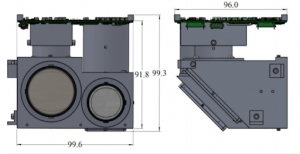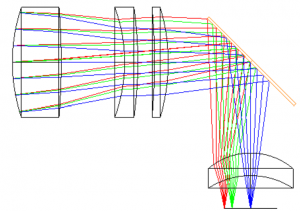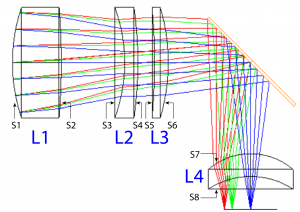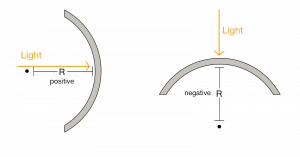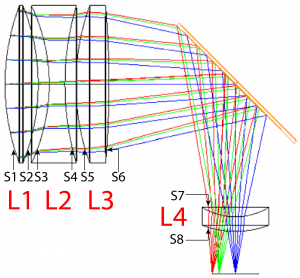Iris Imager
Iris is integrated into Icarus, the cubesat structure, so that both apertures are on the outside face of the cubesat and fit into one unit. The structure is made of Aluminum 6061 T6 and ensures that the optical elements remain in place and are properly attached to Icarus in two places.
The structure houses both the VNIR and SWIR paths, and includes a 45 degree folding mirror for each. The optical pathways and main pathway are rigidly connected to the main housing.
The fasteners used in the optical paths are secured with blind threaded holes and helicoils inserts are embedded into them to avoid the use of nuts and strengthen the threads.
There are special machined holes in the main optical pathway that serve multiple purposes. Some are injection holes for epoxy that is used to pot the lenses and spacers. Others are threaded for screws to hold the baffles in place, and others are to mount the folding mirror along with compression springs.
The lenses are mounted using a detachable baffle that sits inside the primary optical path. The lenses are layered in between a wave spring and a threaded retaining ring that interacts with the baffle. This allows the lens position to be slightly adjusted, and are able to move a maximum of about +/- 0.5mm from the original position.
The mirrors will be mounted using a simple design. The mirrors are made of fused silica, are circular, and have a thickness of 3mm. The set screws are placed along the middle of each mirror edge so the tips are fully in contact to minimize the distortion possibilities. The mirror itself sits in the mirror holder and rests against a frame at the front and has a backing plate lined with 6 pieces of Viton cord stock for support against vibrations it will experience during launch. Minor adjustments to the mirror position can be made using the 4 threaded fasteners placed inside the compression springs.
Iris Optics
Component 1: Visible + Near Infrared (VNIR) Optics
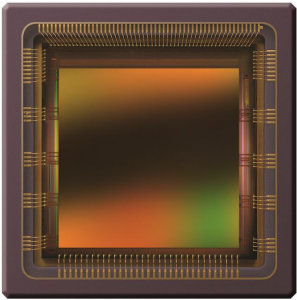
| Average Resolution (400 km altitude): | 192 m |
| Average Resolution (300 km altitude): | 144 m |
| Average Modulation Transfer Function (MTF): | 0.12 |
| Effective Focal Length (EFL): | 85 mm |
| Clear Aperture: | 30 mm |
Filter Specifications
| Sensed Bands of Light: | Blue, Red, NIR (Near Infrared) |
| Overall Wavelength(s): | Blue (465-515 nm), Red (650-680 nm), NIR (845-885 nm) |
| Transmission: | 95% |
| Model: | CMV4000 (by AMS) |
| Pixel Pitch: | 5.5 μm |
Component 2: Short-wave Infrared (SWIR) Optics
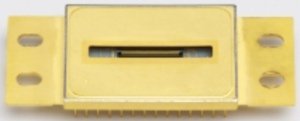
| Average Resolution (400 km altitude): | 358 m |
| Average Resolution (300 km altitude): | 269 m |
| Average Modulation Transfer Function (MTF): | 0.20 |
| Effective Focal Length (EFL): | 112 mm |
| Clear Aperture: | 40 mm |
Filter Specifications
| Sensed Bands of Light: | 2 – 2.2 μm |
| Overall Wavelength(s): | SWIR (Short-Wave Infrared) ~2100 nm |
| Transmission: | ≥60% |
| Model: | G11477-512WB (by Hamamatsu) |
| Pixel Pitch: | 25×250 µm |
The data generation rate is expected to be 2.6 MB/s, for the entire optical system.
Electra
Electra is the printed circuit board (PCB) created in-house at the University of Alberta for the Iris multispectral imaging payload in the Ex-Alta 2 CubeSat for the purpose of providing useful data for wildfire science from a CubeSat platform.
- Image capture and processing.
- Communication between board components (image sensors, temperature sensors, memory), the OBC Athena, and the Electronic Power Supply (EPS).
- On-board Temperature Detection and Sensing,
- Voltage Domain Buffering:
- Signals from different power domains are buffered to prevent unwanted powering of components. Connections to different power domains are present, and are therefore buffered.
- Overcurrent Protection:
- ICs onboard Electra enact mechanisms that prevent damage to components from single-event latch-up damage (SEL) caused by extraterrestrial radiation effects (i.e. solar flare, cosmic radiation). Such events draw exceedingly high currents to components which can cause heavy damage.
- Radiometric resolution of >= 8 bits/pixel.
- Research shows that there is no benefit past 8 bits/pixel with NDVI in mind.
- Consumes less than 10W
The Altera Cyclone V FPGA SoC field-programmable gate array from Intel is used. This can be thought of as the brains of Electra — all the components of Electra communicate to and through this central FPGA and take action based on this data. The device also contains a dual-core microcontroller for software implementation, which allows Electra to communicate to communicate image data to Ex-Alta 2’s OBC Athena. In the case of Overcurrent/SEL, the cubesat Electronic Power System (EPS) will power cycle Electra, and re-boot the FPGA safely.
Electra houses and collects reflectance data from two image sensors in two different groups of wavelength bands: visible + near infrared (VNIR), and shortwave infrared (SWIR).
VNIR data is obtained from the CMV4000 high-speed 4.2 Megapixel CMOS image sensor from ams. SWIR data is obtained from the G11478-512WB linear pixel array from Hamamatsu.
Electra is equipped with six TMP421 temperature sensors that monitor areas that dissipate lots of power. Data is communicated to the central FPGA SoC (Cyclone V) for later transmission to the ground as part of generic housekeeping and monitoring data.
By Sally Palmers, Dipesh Aggarwal and Hans Jarales
Edited by Joshua Purackal
This page was last updated November 2022

